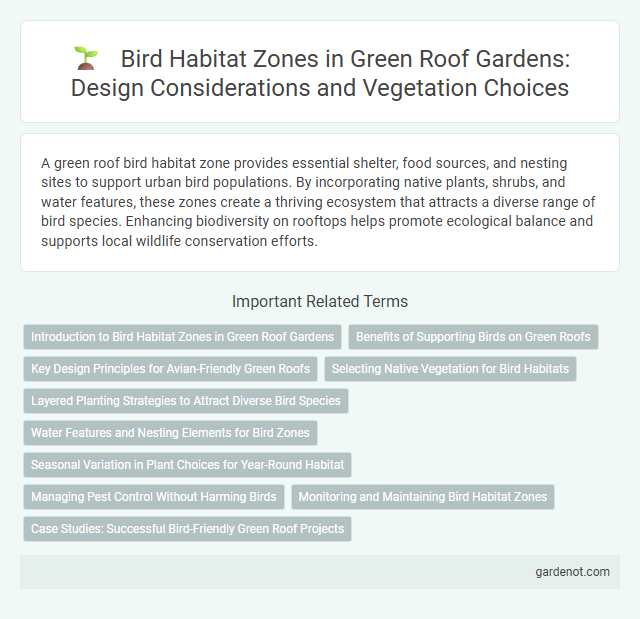A green roof bird habitat zone provides essential shelter, food sources, and nesting sites to support urban bird populations. By incorporating native plants, shrubs, and water features, these zones create a thriving ecosystem that attracts a diverse range of bird species. Enhancing biodiversity on rooftops helps promote ecological balance and supports local wildlife conservation efforts.
Introduction to Bird Habitat Zones in Green Roof Gardens
Bird habitat zones in green roof gardens create specialized environments that support diverse avian species by mimicking natural habitats such as meadow, shrub, and woodland zones. These zones enhance urban biodiversity by providing food sources, nesting sites, and shelter, which are essential for bird survival in densely populated areas. Designing bird habitat zones with native plants and varied structural elements significantly improves ecological connectivity and promotes sustainable urban ecosystems.
Benefits of Supporting Birds on Green Roofs
Supporting birds on green roofs enhances urban biodiversity by providing essential habitats and food sources for various bird species. These habitats contribute to natural pest control, as birds feed on insects that could damage vegetation. Green roofs with bird-friendly features also promote pollination and seed dispersal, aiding the growth of native plants and overall ecosystem health.
Key Design Principles for Avian-Friendly Green Roofs
Designing avian-friendly green roofs requires diverse native plant species that provide food, shelter, and nesting materials to support local bird populations. Structural elements such as varied vegetation heights and natural substrates create safe habitats and promote biodiversity. Incorporating water sources and avoiding reflective surfaces further enhances the suitability of green roofs for bird habitation.
Selecting Native Vegetation for Bird Habitats
Selecting native vegetation for bird habitats on green roofs enhances local biodiversity by providing essential food sources and shelter tailored to indigenous bird species. Plants such as native grasses, wildflowers, and shrubs attract pollinators and insects, supporting bird feeding and nesting behaviors. Integrating diverse native plant species creates a sustainable microhabitat, improving the ecological value of urban green roofs for avian populations.
Layered Planting Strategies to Attract Diverse Bird Species
Layered planting strategies in green roofs create diverse bird habitat zones by combining ground covers, shrubs, and small trees to provide food, shelter, and nesting sites for various bird species. Incorporating native plants with staggered blooming periods enhances year-round foraging opportunities, supporting migratory and resident birds alike. Structural diversity in vegetation layers contributes to increased avian biodiversity by catering to the habitat preferences of different bird species.
Water Features and Nesting Elements for Bird Zones
Water features such as shallow ponds, drip fountains, and misting systems enhance green roof bird habitat zones by providing essential drinking and bathing resources for various bird species. Nesting elements including native plant clusters, birdhouses, and natural materials like twigs and grasses create safe breeding environments that support local avian biodiversity. Integrating these components fosters a sustainable ecosystem, encouraging diverse bird populations to thrive on green roofs.
Seasonal Variation in Plant Choices for Year-Round Habitat
Seasonal variation in plant choices on green roofs enhances bird habitat zones by providing continuous food and shelter throughout the year. Incorporating a diverse mix of native grasses, flowering perennials, and berry-producing shrubs ensures resources during breeding, migration, and winter months. Optimized plant selection supports insect populations and seed availability, crucial for sustaining diverse bird species in urban environments.
Managing Pest Control Without Harming Birds
Effective pest control in green roof bird habitat zones relies on non-toxic methods such as introducing natural predators like ladybugs and using organic insecticidal soaps. Implementing integrated pest management (IPM) techniques minimizes chemical use, protecting avian species and maintaining biodiversity. Regular monitoring ensures early detection of pest issues, enabling targeted interventions that preserve bird health and ecosystem balance.
Monitoring and Maintaining Bird Habitat Zones
Monitoring and maintaining bird habitat zones on green roofs involves regular inspections to track bird activity and assess vegetation health, ensuring the habitat supports native species. Installing remote cameras and acoustic sensors helps gather data on bird presence and behavior without disturbing the environment. Timely removal of invasive plants and replenishment of native flora optimize habitat conditions, promoting biodiversity and enhancing ecosystem resilience.
Case Studies: Successful Bird-Friendly Green Roof Projects
Case studies reveal that bird habitat zones on green roofs significantly increase urban biodiversity, with projects like Chicago's City Hall and the Vancouver Convention Centre demonstrating thriving bird populations and nesting sites. These bird-friendly green roofs utilize native vegetation, water features, and structural diversity to attract species such as sparrows, finches, and chickadees. Measurable outcomes include enhanced migratory stopover habitats and improved ecological connectivity in dense urban environments.
Bird habitat zone Infographic

 gardenot.com
gardenot.com